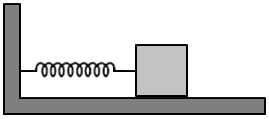Select Chapter Topics:
Which of the following examples represents periodic motion?
| 1. | A swimmer completes one (return) trip from one bank of a river to the other and back. |
| 2. | A freely suspended bar magnet is displaced from its N-S direction and released. |
| 3. | Swaying off the branches of the tree. |
| 4. | An arrow released from a bow. |
Prefer Books for Question Practice? Get NEETprep's Unique MCQ Books with Online Audio/Video/Text Solutions via Telegram Bot
NEET MCQ Books for XIth & XIIth Physics, Chemistry & Biology| 1. | The rotation of the earth about its axis. |
| 2. | The motion of an oscillating mercury column in a \(U\text-\)tube. |
| 3. | General vibrations of a polyatomic molecule about its equilibrium position. |
| 4. | A fan rotating with a constant angular velocity. |
Prefer Books for Question Practice? Get NEETprep's Unique MCQ Books with Online Audio/Video/Text Solutions via Telegram Bot
NEET MCQ Books for XIth & XIIth Physics, Chemistry & BiologyThe figure depicts four \(({x\text-t})\) plots for the linear motion of a particle.
| (a) |  |
| (b) |  |
| (c) |  |
| (d) |  |
Which of the following is true?
| 1. | (a) is periodic but (c) is not periodic |
| 2. | (b) is periodic but (d) is not periodic. |
| 3. | (b) and (d) are periodic. |
| 4. | only (c) is periodic. |
Prefer Books for Question Practice? Get NEETprep's Unique MCQ Books with Online Audio/Video/Text Solutions via Telegram Bot
NEET MCQ Books for XIth & XIIth Physics, Chemistry & Biology1. \(\frac{\pi}{\omega}\)
2. \(\frac{4 \pi}{\omega}\)
3. \(\frac{3 \pi}{\omega}\)
4. \(\frac{2 \pi}{\omega}\)
Prefer Books for Question Practice? Get NEETprep's Unique MCQ Books with Online Audio/Video/Text Solutions via Telegram Bot
NEET MCQ Books for XIth & XIIth Physics, Chemistry & Biology| 1. | a simple harmonic function. |
| 2. | a simple harmonic function but not a periodic function. |
| 3. | both periodic and simple harmonic functions. |
| 4. | only periodic function. |
Prefer Books for Question Practice? Get NEETprep's Unique MCQ Books with Online Audio/Video/Text Solutions via Telegram Bot
NEET MCQ Books for XIth & XIIth Physics, Chemistry & BiologyA particle is in linear simple harmonic motion between two points, \(A\) and \(B\), \(10~\text{cm}\) apart. (Take the direction from \(A\) to \(B\) as the positive direction.) The signs of velocity, acceleration, and force on the particle when it is at \(3~\text{cm}\) away from \(A\) going towards \(B\) are:
| 1. | Zero, Negative, Negative |
| 2. | Negative, Zero, Zero |
| 3. | Negative, Negative, Negative |
| 4. | Positive, Positive, Positive |
Prefer Books for Question Practice? Get NEETprep's Unique MCQ Books with Online Audio/Video/Text Solutions via Telegram Bot
NEET MCQ Books for XIth & XIIth Physics, Chemistry & BiologyWhich of the following relationships between the acceleration \(a\) and the displacement \(x\) of a particle involves simple harmonic motion?
1. \(a = 0 . 7 x\)
2. \(a = - 200 x^{2} \)
3. \(a = - 10 x\)
4. \(a = 100 x^{3}\)
Prefer Books for Question Practice? Get NEETprep's Unique MCQ Books with Online Audio/Video/Text Solutions via Telegram Bot
NEET MCQ Books for XIth & XIIth Physics, Chemistry & BiologyA spring balance has a scale that reads from 0 to 50 kg. The length of the scale is 20 cm. A body suspended from this balance, when displaced and released, oscillates with a period of 0.6 s. What is the weight of the body?
1. 219 N
2. 196 N
3. 223 N
4. 225 N
Prefer Books for Question Practice? Get NEETprep's Unique MCQ Books with Online Audio/Video/Text Solutions via Telegram Bot
NEET MCQ Books for XIth & XIIth Physics, Chemistry & BiologyA spring having a spring constant of \(1200\) N/m is mounted on a horizontal table as shown in the figure. A mass of \(3\) kg is attached to the free end of the spring. The mass is then pulled sideways to a distance of \(2.0\) cm and released. The frequency of oscillations will be:
| 1. | \(3.0~\text{s}^{-1}\) | 2. | \(2.7~\text{s}^{-1}\) |
| 3. | \(1.2~\text{s}^{-1}\) | 4. | \(3.2~\text{s}^{-1}\) |
Prefer Books for Question Practice? Get NEETprep's Unique MCQ Books with Online Audio/Video/Text Solutions via Telegram Bot
NEET MCQ Books for XIth & XIIth Physics, Chemistry & BiologyA spring having a spring constant of \(1200\) N/m is mounted on a horizontal table as shown in the figure. A mass of \(3\) kg is attached to the free end of the spring. The mass is then pulled sideways to a distance of \(2.0\) cm and released. The maximum acceleration of the mass is:
| 1. | \(6\) ms–2 | 2. | \(8\) ms–2 |
| 3. | \(3.3\) ms–2 | 4. | \(5.1\) ms–2 |
Prefer Books for Question Practice? Get NEETprep's Unique MCQ Books with Online Audio/Video/Text Solutions via Telegram Bot
NEET MCQ Books for XIth & XIIth Physics, Chemistry & Biology

